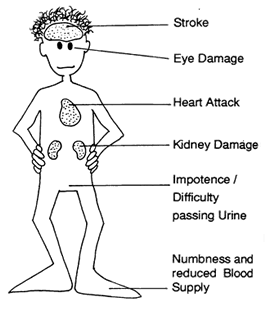Scientists
at the Institute of Toronto General Hospital have discovered a new
signaling pathway between three organs - the gut, brain and liver - may
lower blood sugar if enabled.
Currently, people with diabetes to reduce glucose levels by diet,
exercise, oral antidiabetics and insulin injections (usually several
times a day) and to monitor glucose levels in Regular blood.
High glucose levels can damage the eyes, nerves and kidneys, increase
the risk of heart attack, stroke, blindness, erectile dysfunction, foot
problems and the possibility of amputation.
Many laboratories around the world are scrambling to find alternative
measures can effectively lower glucose levels because of the serious
consequences due to the excess sugar in the blood cause.
Group led by Dr. Tony Lam use the mouse to find out the fat can
activate a subset of nerves in the intestine, generated signals are sent
to the brain and then to the liver to lower glucose levels or the
production of sugar.
But just consumed a high-fat diets in three days is enough to signal
interference, the disabled, and making it impossible for other agencies
reported lower blood glucose levels.
This work has been published as an article called "The fat in the intestine gut-brain axis formation-liver has the ability to regulate glucose production" in the online edition of the international specialized scientific sites Nature .
According to Dr. Lam, who holds the Chair John Kitson McIvor Diabetes
Research at the University Health Network and University of Toronto,
"This is a new approach in developing more effective ways to reduce the
amount of glucose blood in people with diabetes or obesity. "
 |
High
glucose levels can damage the eyes, nerves and kidneys, increase the
risk of heart attack, stroke, blindness, erectile dysfunction, the
evidence leg numbness. (Photo: dav.gov.au)
|
Dr. Lam emphasized,
"We know the brain and liver can adjust the amount of glucose in the
blood, but the question here is how can a therapist in these two
agencies which do not suffer the side effects ? We can find a way to bypass this problem by showing that the gut is the initial target. Very
close with a remote control device, the gut is able to deliver signals
to the brain and brain turn signals the liver to lower glucose
production. If
these medicines can be developed to enable recognition mechanisms in
the gut, we can get an effective method to inhibit the production of
sugar by the body, which can reduce blood glucose levels of people with
diabetes. "
Dr. emphasizes that it will take years of testing to determine whether
this approach is effective and safe for people with diabetes.
More than two million Canadians suffer from diabetes.
According to Dr. Gary Lewis, Head of Endocrinology and Metabolism at
the University of energy Health Network and Mount Sinai Hospital,
Toronto, and is a lecturer Pharmacology and Physiology at the University
of Toronto, the "Diabetes is a disease now Translation in Canada
and around the world with the number of patients increased to alarming
levels, consume a lot of resources valuable health care. We
have evidence from clinical trials showed that lowering blood sugar to
normal levels in people with diabetes will have a significant impact on
the prevention of serious consequences. So we understand how to control the content of an effective and less vulnerability great importance. The
work of Dr. Lam has unveiled a new round of conditioning showed targets
and new areas to lower blood sugar in people with diabetes and obesity.
"
Dr. Richard Weisel, Director of General Studies Institute Toronto
(TGRI), Professor and Chairman of the Department of Heart Surgery at the
University of Toronto, said he welcomes any potential interventions
that may help reduce blood sugar, "The work has demonstrated that
the levels of glucose in the blood are more likely to die from heart
disease, so anything that can help lower the amount of sugar will help
reduce process and the risk of dying of cardiovascular disease. "
Dr. Diane Finegood, Scientific Director of the Institute of Nutrition, Metabolism and Diabetes Energy, part of the Canadian Institute of Health Research (CIHR) said, "The discovery of Tony is an exciting breakthrough could lead to new treatment for diabetes. I am pleased that CIHR played an important role in the financing of this project. "
Mice, Dr. Lam and colleagues designed and performed a series of
experiments showed that the first small fat enters the small intestine
generate afferent nerve signals to the brain, the brain then passes
signal to the liver to reduce the production of glucose and glucose in
the blood by little every 15 minutes.
This decline does not occur when the nerve between the gut and the
brain or between the brain and liver were removed or blocked.
The process reduces glucose also deactivated when mice were fed a
high-fat diet for three days prior to the experiment, the findings show
that people who consume more fat loss signal transmission This benefit.



0 comments:
Đăng nhận xét